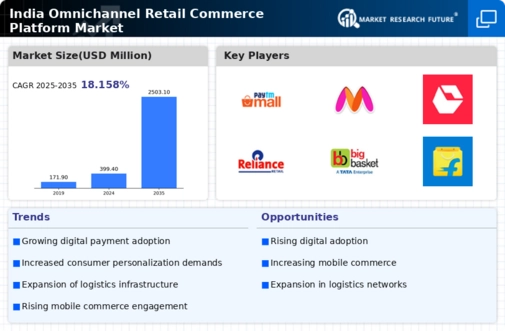Rising Internet Penetration
The omnichannel retail-commerce-platform market in India is experiencing a notable boost. This boost is due to the increasing internet penetration across the country. As of November 2025, approximately 700 million individuals have access to the internet, which represents a penetration rate of around 50%. This surge in connectivity facilitates seamless online shopping experiences, enabling consumers to engage with brands through multiple channels. The omnichannel retail-commerce-platform market is likely to benefit from this trend, as businesses can reach a broader audience and enhance their customer engagement strategies. Furthermore, the growing use of smartphones, which account for over 80% of internet access, suggests that mobile commerce will play a pivotal role in shaping the future of retail in India.
Evolving Consumer Preferences
Consumer preferences in India are rapidly evolving, with a marked shift towards convenience and personalized shopping experiences. The omnichannel retail-commerce-platform market is adapting to these changes by offering tailored solutions that cater to individual customer needs. Recent surveys indicate that over 60% of Indian consumers prefer shopping across multiple channels, including online and offline platforms. This trend highlights the need to integrate various touchpoints for a cohesive shopping experience. Retailers are increasingly investing in data analytics to understand consumer behavior better, which may lead to enhanced customer satisfaction and loyalty. As a result, the omnichannel retail-commerce-platform market is likely to see sustained growth driven by these changing consumer dynamics.
Increased Focus on Data Security
As the omnichannel retail-commerce-platform market in India continues to expand, the emphasis on data security has become increasingly paramount. With rising concerns over data breaches and privacy issues, consumers are becoming more cautious about sharing their personal information. Recent studies indicate that nearly 70% of Indian consumers prioritize data security when engaging with online retailers. In response, businesses are investing in robust cybersecurity measures to protect customer data and build trust. This focus on data security not only mitigates risks but also enhances the overall customer experience, as consumers feel more secure when shopping across various channels. Thus, the omnichannel retail-commerce-platform market is likely to benefit from these heightened security measures, fostering consumer confidence and loyalty.
Government Initiatives and Support
Government initiatives aimed at promoting digital commerce are playing a crucial role in shaping the omnichannel retail-commerce-platform market in India. Policies such as the Digital India campaign and the Make in India initiative are designed to foster a conducive environment for e-commerce growth. As of November 2025, the government has introduced various incentives for startups and small businesses, encouraging them to adopt digital platforms. This support is likely to enhance the competitiveness of the omnichannel retail-commerce-platform market, as more players enter the space and innovate their offerings. Furthermore, regulatory frameworks that facilitate cross-border e-commerce may also contribute to market expansion, providing opportunities for Indian retailers to reach international customers.
Investment in Logistics and Supply Chain
The omnichannel retail-commerce-platform market in India is significantly influenced by advancements in logistics and supply chain management. With the rise of e-commerce, companies are investing heavily in improving their logistics capabilities to ensure timely and efficient delivery of products. As of November 2025, the logistics sector in India is projected to grow at a CAGR of 10%, driven by the increasing demand for faster delivery options. This investment not only enhances operational efficiency but also improves customer satisfaction, as consumers increasingly expect quick and reliable service. Consequently, the omnichannel retail-commerce-platform market is likely to thrive as businesses leverage these logistics advancements to provide a seamless shopping experience.






















Leave a Comment